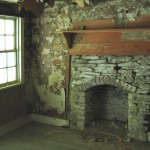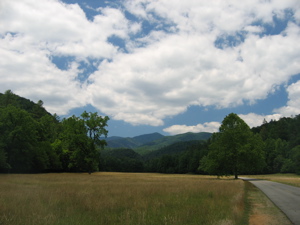 At the turn of the twentieth century, Cataloochee, with 1,200 residents, was one of the most populous and economically enterprising regions of what today is the Great Smoky Mountains National Park. A significant number of inhabitants were engaged in commercial apple growing (with stock purchased from Stark Brothers Nurseries in Missouri), and community leaders had already discovered the satisfying moneymaking possibilities of tourism. The largest number of historic buildings in the park (including two churches and a school) is preserved here.
At the turn of the twentieth century, Cataloochee, with 1,200 residents, was one of the most populous and economically enterprising regions of what today is the Great Smoky Mountains National Park. A significant number of inhabitants were engaged in commercial apple growing (with stock purchased from Stark Brothers Nurseries in Missouri), and community leaders had already discovered the satisfying moneymaking possibilities of tourism. The largest number of historic buildings in the park (including two churches and a school) is preserved here.
The National Park Service touts Cataloochee as an off-the-beaten path destination for those trying to escape the crowds; and the ten-mile trip from I-40, on the eastern side of the park, includes two miles of narrow gravel road, perhaps deliberately left unpaved to dampen visitation. Cataloochee is one of the largest tracts of wilderness in the East, and the NPS chose to reintroduce elk here at the beginning of the twenty-first century. Nevertheless, campers gravitate to Cataloochee, and commercial horseback riding has long been a tradition in this section of the park.
Although Cataloochee includes some worthwhile trails and better-than-average opportunities to view wildlife, the real lesson of this section of the park is how quickly the traces of man can be obliterated by the forest. It is one thing to recognize in theory how quickly nature reclaims what man has (in this case, unwillingly) abandoned; it’s another thing to compare first-hand the early twentieth century photos of the W. G. B. Messer property, cleared by farming and logging operations, with the park land of today. Only fragments of stone walls, pieces of metal, and some roses and yucca suggest that people ever lived here, let alone that some lived in two-story frame houses and ordered merchandise from the Sears, Roebuck catalog.
Day hikers visiting this more isolated section of the park from the Matzkos’ cottage require a full-day commitment because the Cataloochee entrance is approximately 90 miles from Lake Santeetlah. Furthermore, although there is a ranger office (behind a private residence), it is rarely manned, and this whole section of the park has a run-down-at-the-heels appearance when compared with the Great Smoky Mountain National Park that most tourists associate with the 441 corridor.
At Cataloochee there is some old-growth forest and a significant number of historic structures, but the plethora of horses means that the average day hiker (like Theodore Roosevelt’s revised version of Bunyan’s “Man with the Muckrake”) will spend more than the usual amount of time fixing “his eyes with solemn intentness on that which is vile and debasing.” Of course, you could also ride a horse.